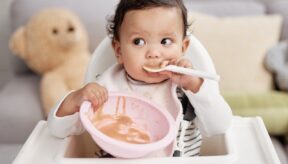Starting solids with your baby is exciting but find it overwhelming to sort out how and when to introduce food to your baby. Especially with ever-changing research and recommendations. Here’s a run-down of the options and current recommendations.
Babies are typically ready to start being introduced to solid foods around 6 months of age. If your little one is showing signs of readiness and you’ve talked to your doctor about starting solids, it’s time to take the plunge. Starting your baby on solids is an exciting time, but personally I found the transition really challenging. There seemed to be a million different ways to introduce new foods; I didn’t know whether I should be pureeing sweet potato or handing my baby a piece of steak. Not to mention, my baby choked on absolutely everything which was incredibly stressful.
Signs of Readiness
How do you know when your baby is ready to start eating more than breastmilk or formula? There are a few key indicators that will let you know your little one is ready, including them being able to sit on their own, showing interest in your food, and being able to push food to the back of their mouth to swallow. Personally, I also talked to my doctor about it at a check-up to make sure I wasn’t jumping the gun and to get a few tips for starting the transition.
Now that you’re ready, how do you go about initiating solids? There are two camps when it comes to the weaning world. Both offer unique benefits and have their own advantages, but honestly, you need to do what works for you and your baby. Health Canada recommends using a combination of the two methods. Whether you opt for baby-led weaning, the traditional method, or a combination of both, the important thing is that you’re introducing your baby to a variety of healthy, iron-rich foods.
Baby-Led Weaning
Baby-led weaning promotes independent eating, rather than spoon-feeding done by parents. Essentially, you allow your baby to lead the way, handing them graspable finger foods from the dinner table. This method is said to improve dexterity, aid in early motor skill development and decrease picky eating. All wins, right? Personally, I loved the idea behind baby-led weaning, and was convinced that it was be the route we went when we introduced solids for our daughter. Research shows that there is no increased risk of choking with baby-led weaning and we knew lost of families had great success with this method. We, however, had a few scary instances with our daughter choking so decided to opt for purees until our daughter was older.
Traditional Spoon-Feeding
The traditional spoon-feeding method involves feeding your babe purees around 6 months, then slowly introducing lumps a few weeks later before eventually transitioning to more textured foods. Chances are, this is the way your mom weaned you and it is still respected as an acceptable option by health professionals. Some advocates for traditional method suggest that transitioning your baby from a diet of only milk to processing solid foods is too big a leap for your baby’s digestive system. Not to mention, those premade pouches are way too convenient to pass up when you’re on the go!
Iron, Iron, Iron
Whichever method you opt for, the type of foods you are feeding your baby is more important than the form you give them in. Babies iron stores begin to deplete around 4-6 months, which means that getting iron from their diet is extremely important. Health Canada recommends babies get 11mg of iron a day from foods such as meats, iron-fortified cereals, or iron-rich fruits and vegetables—that’s more than the requirement for an adult male! Foods rich in Vitamin C are also key, as they will aid in the absorption of iron. Including a variety of foods is crucial to ensure your baby gets a balance of protein, carbohydrates, fats, vitamins and minerals.
Foods to Avoid
While most foods are safe to feed your baby from the get-go, there are a few things to avoid until the time’s right. It is recommended to avoid feeding your baby honey until they are one year old because of the risk of infant botulism, a rare but serious form of food poisoning.
Cow’s milk is another food that you should wait until your child is 9-12 months old before introducing. Ensure your baby is eating a variety of other foods, and that you’re not giving them more than 3 cups per day for babies 9-24 months old.
In addition, popcorn, nuts and other candy should be avoided until your child is four years old. Foods that pose as a choking hazard and shouldn’t be consumed until children can chew and swallow better, around age four.
*Opinions expressed are those of the author, and not necessarily those of Parent Life Network or their partners.



 Sponsored
Sponsored




